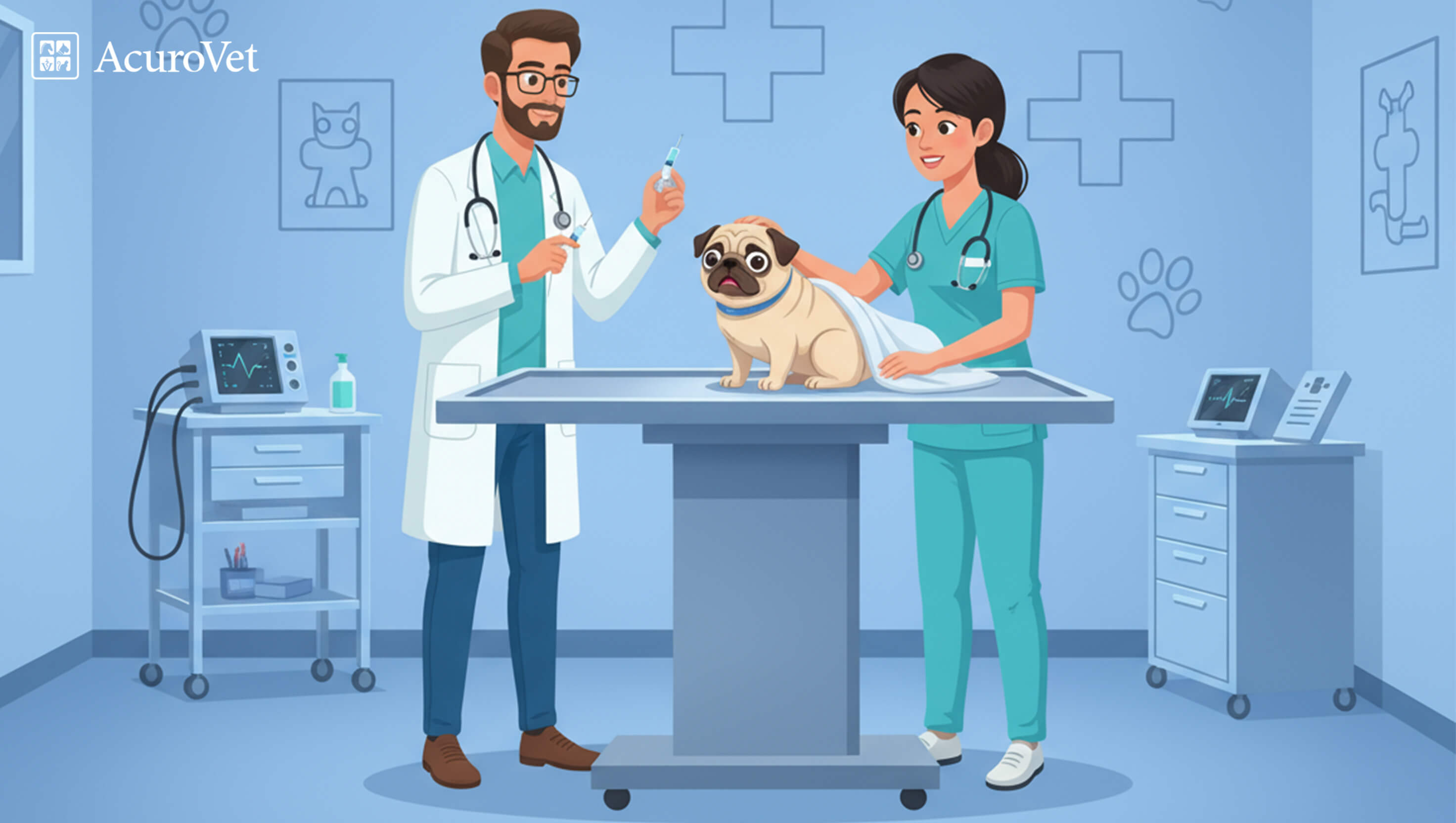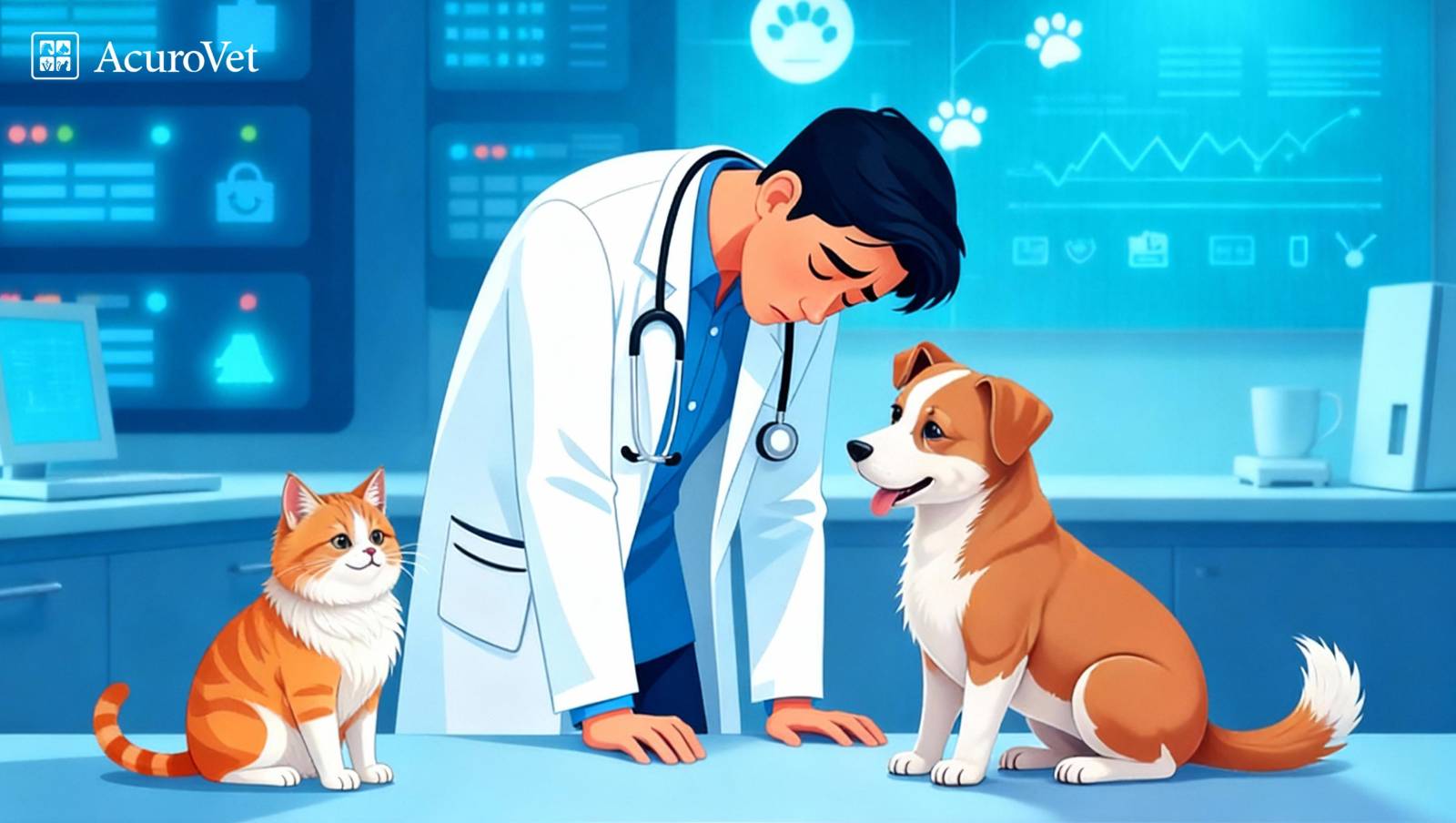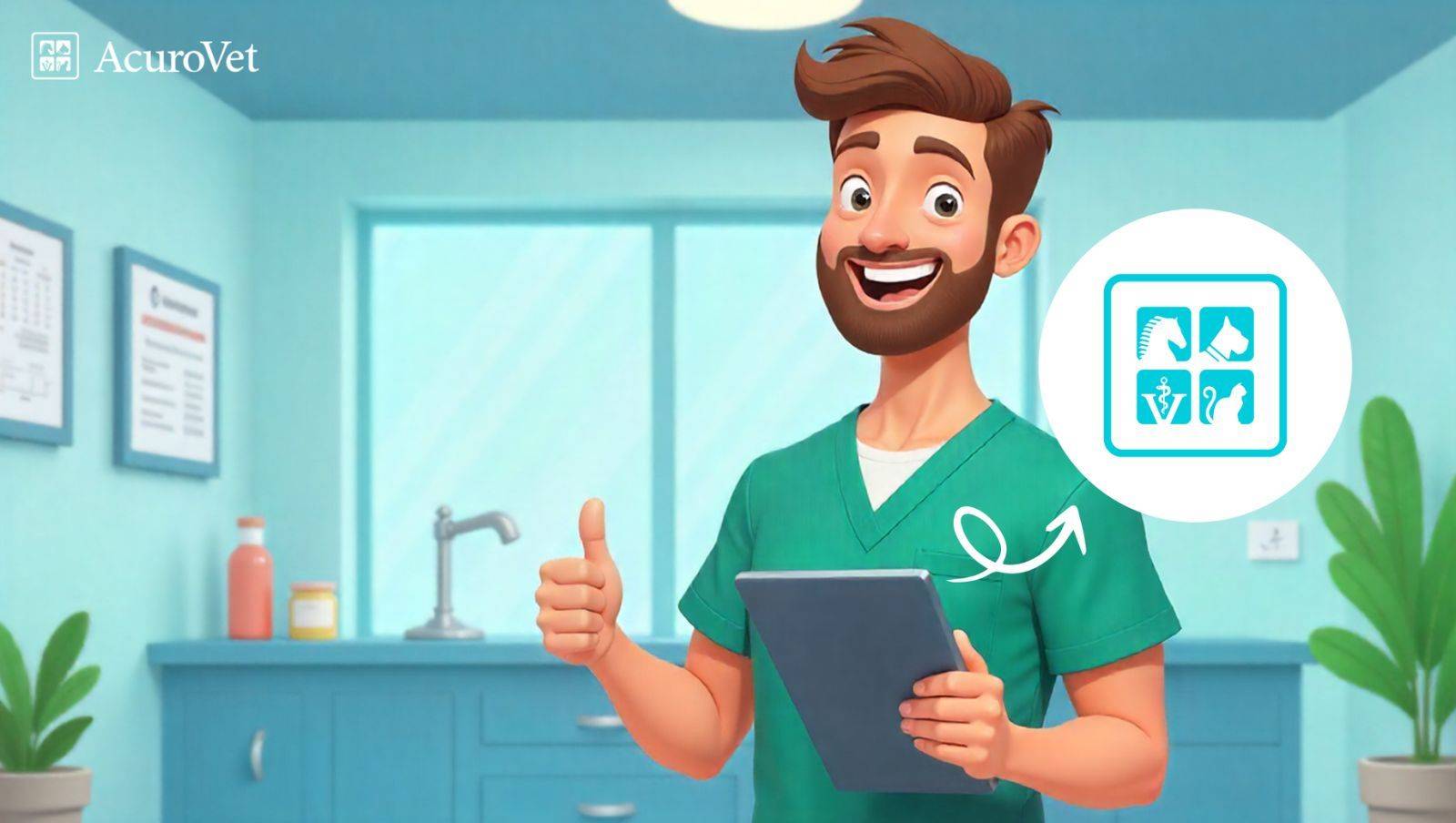
How To Handle Anxious Pets As A Veterinarian In 2025
Learn how to recognize stress signals, create calmer clinic environments, and handle anxious pets with confidence. A practical guide for veterinarians committed to low-stress, behavior-first care in 2025.

- Introduction
- Understanding Pet Anxiety: Signs Every Vet Should Know
- The Impact of Anxiety on Veterinary Care
- Creating a Calming Environment in Your Clinic
- Low-Stress Handling Techniques Every Vet Should Use
- Behavior-Based Interaction & Staff Training
- Building Positive Associations With the Vet Clinic
- Including Pet Parents in the Strategy
- When to Consider Medication or a Behavior Specialist
- Tracking and Improving With AcuroVet Wellness Tools
- Creating Calm and Safe Veterinary Visits
- FAQ
Introduction
2020 was a year that redefined the relationships between pets and their owners. With most of them at home, pets connected strongly with their owners and were overjoyed with the extra time they were getting with them. Come 2023, and people started heading back to work, and the result was many more anxious pets.
Anxious pet handling is one of the most common challenges veterinarians are facing in 2025. Such pets are less cooperative and create a menace at the clinic, jeopardizing staff safety and compromising diagnostic accuracy. If you’re a veterinarian, here’s a guidebook on how to handle anxious pets with the right tools and strategies.
Understanding Pet Anxiety: Signs Every Vet Should Know
As of 2025, more pets are displaying more stress given to the fast-paced lifestyle of the homes they’re in, and also a noticeable collective behavioral change post-pandemic. As an experienced veterinarian, you are expected to be excellent at discerning pet anxiety symptoms. Some pets may hide behind their folks or growl at you, and it's up to you to understand their communication signals and anxiety levels.
For reducing pet fear and making vet visits an enjoyable experience, here are a few signs that you need to look out for:
- Excessive noises like growling or barking
- Restlessness and prancing around
- Trembling and/or shaking
- Loss of appetite
- Hesitant when approached or becomes stiff
- Avoid eye contact
- Ready to bite or scratch
A key component of anxious pet handling is recognizing and handling different anxiety levels. Doing so helps you make quick adjustments, such as lowering the sensory load within the clinic and maintaining a calm environment where all your patients receive the best veterinary treatment for their anxiety and other health issues.
The Impact of Anxiety on Veterinary Care
Similar to humans, animals become incompetent and don’t function to their best capacities when anxious. This makes a normal lifestyle and vet visits a challenging task. When the animal is stressed, conducting routine activities like blood tests, temperature checks, body cleanups, etc., is next to impossible, leading to delayed checkups and even restraining measures.
Here’s how anxiety impacts veterinary care:
- Reduced patient compliance, making all routine visits and checkups cumbersome
- High risk of injuries and clinics at the clinic to anyone, including the pet
- Incorrect or inaccurate diagnostic reports due to changes in hormone levels
- You and your staff may end up with compassion fatigue, dealing with anxious patients almost every day
- Disrupted workflow efficiency at the clinic, leading to scheduling changes with both veterinarians and clinics.
Veterinary health partners highlight that reducing pet anxiety improves patient outcomes and improves client satisfaction.
Creating a Calming Environment in Your Clinic
Your clinic’s ambience plays a vital role in how pets behave or react because they’re big on vibes. For anxious pets, simple factors like the light, sounds, and smells can be triggering. Therefore, you need to have spaces that are calm and soothing so that everyone who visits or works there feels the same.
The following are a few interior elements you can implement to create a calming environment in your clinic:
- Separate waiting areas for different species, like cats and dogs
- Special design elements like nonslip flooring, soft/warm lighting, pheromone diffusers, and soothing sounds playing in the background
- Provide comfort tools like towel wraps or covered carriers, and ask pet owners to bring the pet’s favorite toys for familiar smells
- Limit noises and provide visual barriers/screens to limit a pet’s view and minimize other sensory triggers
- Keep spaces uncluttered and equipped with toys and treats to provide an enjoyable and safe space.
Low-Stress Handling Techniques Every Vet Should Use
You need to deliver low-stress veterinary care so that all medical examinations and procedures can happen without any hassle, especially for anxious pets. The following are a few low-stress handling techniques that you should use for safe procedures, clinical efficiency, and most importantly, the emotional well-being of each animal that comes to you.
-
Adopt cooperative care approaches
Give the pet the needed space to reveal their state of mind and be themselves. Let them decide what they want to do and how they want it to be done-like stepping onto a scale, choosing a treat, approaching you at their own pace, etc. These minute steps make them feel that they’re in control and thus, a lot safer in your veterinary clinic.
-
Use gentle handling tools
Envelope cats and small animals in towel wraps to make them feel secure. Use calming caps to limit visual overstimulation. Focus on positioning and support to minimize restrictive methods.
-
Have some distractions handy
Who doesn’t love treats? Keep toys, treats, and even lick mats handy to foster a bond with the pets. These play a major role in redirecting their attention, reducing pet fear, and creating positive associations with the veterinarian and the veterinary clinic.
-
Maintain proper body language
Communicate with a calm and slow body language. Speak softly, avoid long eye contact, don’t loom too much over the pets, and maintain a relaxed composure around the animals while checking and treating them. Your body language has a direct impact on how the animal perceives the atmosphere in the room and helps them relax, knowing they’re in good hands.
-
Prioritize comfort over speed
Your patient’s comfort must always be your priority. Avoid getting things done quickly and in a haphazard manner, as they trigger anxious pets. Slowing down limits the need for restraint and results in more efficient and successful appointments, treatments, surgeries, etc.
Behavior-Based Interaction & Staff Training
A calm veterinary clinic is only possible when there’s a well-trained team. Here’s how you can equip your staff with the needed skills:
-
Train staff to recognize stress signals
Make sure that your staff knows the challenges one can face with anxious pets. Train them to identify body language like licking, barking, trembling, etc., to provide the best treatment accordingly while being safe and aware.
-
Use stress checklists and behavior observation forms
Have stress checklists and behavior observation forms that you and your staff can share so that everyone is updated about the patient’s emotional history. Stress checklists help in categorizing stress levels and making the environment calm accordingly. Behavior observation forms help in making a record of what triggers the pet, their responses, and calming strategies that have worked for them.
-
Strengthen client communication skills
Your staff must be well-trained in communicating the hows and whys of all the veterinary anxiety strategies that they use for the patients. Your client will trust you for all their pet’s safety and welfare only when your clinic is transparent in providing the needed information.
-
Have continuous and consistent team training exercises
Conduct workshops and have team discussions whenever possible so that your staff knows all steps in reducing pet fear. This consistent communication will make them confident about providing each pet patient with the best possible treatment for their anxiety and other health issues.
-
Prioritize behavior for all patients and procedures
Most importantly, create a behavior-first mindset throughout your clinic. Your staff needs to know that emotional well-being comes first, and then the medical treatment. Similarly, they too need to ensure that their emotional state is healthy so that they’re able to be empathetic towards the animals. Behavior management is a core component of high-quality and low-stress veterinary care.

Building Positive Associations With the Vet Clinic
Pets need to form friendly relationships with clinics and have positive memories there. Their anxiety levels fall down dramatically when they see your clinic as a place of trust and safety. Here’s how you can build positive associations with pets towards your veterinary clinic:
- From the moment they enter the door to the final stage of their health procedure, use treats, toys, gentle petting techniques and good words to create positive emotional connections.
- Train your clients to make their pets comfortable with leashes, carriers, car seats, travel routes and waiting times to reduce pre-clinic visit stress.
- Make each clinic visit a positive experience for them so that overall veterinary care becomes easy for both you and your staff.
Including Pet Parents in the Strategy
Undoubtedly, pet parents shape their pets’ perspective towards a veterinarian and a veterinary clinic. Their emotional response automatically affects the animal’s response too. When your clients are in a calm and composed state of mind, they significantly reduce the pets’ anxiety levels too, even before reaching the clinic. Encourage your clients to use the following simple and effective veterinary anxiety strategies to prep for their pet’s visit:
- Encourage light exercises at home to ward off nervousness. Maintain consistent feeding schedules so that the pet isn't overstimulated or nauseous.
- Suggest bringing familiar items like toys, treats, blankets, and anything that helps the animal feel grounded and secure, even in stressful environments.
- Owners' anxiety can rub off on their pets. A calm pet parent sets the right tone for their pet to mirror throughout their clinic visit. (Source)
- Share infographics and digital reminders explaining to pet parents how they can prepare their pet for vet visits, what to bring along, and what to expect.
When to Consider Medication or a Behavior Specialist
While most anxious pets are cured with environmental changes, some animals experience anxiety at such alarming levels that additional intervention becomes necessary. You must be able to recognize such situations for the safety of the pet and your team, and also to ensure humane treatment. Here’s how you can help:
- Identify pets showing extreme anxiety and risking themselves, and show them to behavior specialists
- Use short-term calming aids like pheromone sprays, natural supplements, and prescribed calming medicines
- Pets with long-term anxiety need behavior specialists who will modify treatment plans and medications upon thorough research and keen observation.
Tracking and Improving With AcuroVet Wellness Tools
Anxiety management isn’t a one-time thing that ends after an appointment. It needs consistent tracking and communication to be 100% sure that your patient is improving over time. AcuroVet’s wellness tools make this process seamless by:
- Record patient anxiety levels and create an emotional well-being record for each pet
- Set reminders to follow up with clients and update them with desensitization plans
- Maintain detailed reports of the pet’s behavioral improvement after every clinic visit
- Helps ensure continuity across vet teams through shared digital data.
Creating Calm and Safe Veterinary Visits
Reducing pet fear and anxiety not only protects the pet and the veterinary team from injury but also improves client trust and overall animal health. Clinics that have a behavior-first approach and are committed to low-stress veterinary care see accurate diagnostics and happy vet visits.
With smart solutions like AcuroVet, you can discover newer and tech-forward ways to track patient behavior, improve compliance, and create calmer visits. Wish to see more happy vet visits at your clinic? Try AcuroVet today!
Q.1 What causes pet anxiety during veterinary visits?
Pet anxiety can stem from unfamiliar smells, sounds, past negative experiences, separation from owners, restraint, loud environments, other pet patients, or even a pet parent’s own stress.
Q.2 How can veterinarians identify anxiety in pets quickly?
Signs include trembling, growling, hiding, panting, prancing, dilated pupils, stiffness, loss of appetite, or attempts to escape. Observing body language during intake, waiting areas, and exams helps vets tailor handling methods immediately.
Q.3 What are the most effective low-stress handling techniques for anxious pets?
Veterinarians should allow cooperative care, avoid sudden movements, use towel wraps or calming caps, apply minimal restraint, speak softly, and rely on distraction tools like treats or toys to redirect attention.
Q.4 How can veterinary clinics create a calming environment for anxious pets?
Use species-separated waiting areas, pheromone diffusers, warm lighting, nonslip floors, soft music, visual barriers, covered carriers, and clutter-free exam spaces. Small environmental changes significantly reduce sensory overload.
Q.5 Do anxious pets affect diagnostic accuracy and treatment outcomes?
Yes. Anxiety can elevate heart rate, temperature, and hormone levels, all of which can affect diagnostic results. Stress also reduces cooperation, making routine procedures harder and increasing the risk of injury.
Q.6 How can vet teams be trained to manage anxious pets better?
Teams should learn to recognize stress signals, use behavior observation forms, follow stress-level checklists, communicate empathetically with clients, and prioritize emotional well-being before medical tasks.
Q.7 What role do pet parents play in reducing their pet’s anxiety?
A calm pet parent helps calm the animal. Vets should guide clients to bring familiar items, maintain pre-visit routines, practice light exercise, and stay composed. Pre-visit education reduces stress even before entering the clinic.
Q.8 When should a veterinarian consider medication for anxiety?
Medication or behavior consultation is recommended when a pet shows extreme fear, becomes a safety risk, or has chronic anxiety that does not improve with environmental and handling changes.
Q.9 Can digital tools help track anxiety levels in veterinary patients?
Yes. Tools like AcuroVet’s wellness tracking system allow vets to document stress levels, update behavioral notes, schedule follow-ups, and maintain consistent records across the team, ensuring long-term improvement.
Q.10 How can clinics build long-term positive associations for anxious pets?
Use treats, gentle greetings, low-stress handling, consistent staff behavior, shorter wait times, and positive reinforcement throughout the visit. Over time, pets begin associating the clinic with safety instead of fear.

webinars, blogs, resources & more.
for 30 Days!

Recent blog posts

Nov 05, 2025
practice managementHow to Handle Veterinary Burnout and Be Better at Stress Management as a Veterinarian
Discover practical strategies to manage stress, prevent burnout, and improve well-being as a veterinarian through self-care, support, and solutions.

Oct 11, 2025
practice managementHow is AcuroVet the Best Veterinary Software for Vet Clinics in 2025
Discover how AcuroVet stands out as the best veterinary software for vet clinics in 2025 by managing endless paperwork, managing teams and reduce cost
